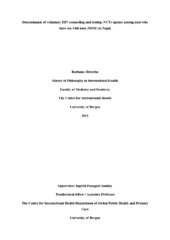| dc.description.abstract | Background: In an era of treatment as prevention, voluntary HIV counseling and testing (VCT) is a crucial point to link individuals with HIV infection with treatment, care and support. VCT also promotes safer behavior (e.g. use of condoms) among both HIV- positive and HIV-negative individuals. In Nepal, the epidemic is concentrated among the most vulnerable populations, such as men who have sex with men (MSM). The 2012 bio- behavioral survey findings suggest that the uptake of VCT is 44.8% among MSM despite rapid expansion of interventions in Nepal. This study looks at the determinants of VCT uptake among MSM using Anderson's model of the utilization of health care. Methods: A cross-sectional survey was carried out between September and November 2010 through snowball sampling to recruit 339 MSM, aged 15 or older, from 15 districts of Nepal. The dependent variable was if they had ever used VCT services. The independent factors included were categorized as predisposing, enabling, need and health system factors, in accordance with Anderson's model of health care utilization. Associations between the independent and the dependent variables were examined using bivariate and multivariate logistic regression analysis in SPSS. The analyses were adjusted for clustering. Results: Among the 339 MSM interviewed, 87% reported they had at some time used VCT services. The predisposing factors associated with being less likely to have used VCT services were being unemployed (adjusted odds ratio (AOR) 0.27, 95% confidence interval (CI) 0.10-0.72), and belonging to the middle caste (AOR 0.20, 95% CI 0.10-0.57). Lack of the enabling factor - family acceptance of same sex behavior' - was inversely associated with ever having used VCT (AOR 0.34, 95% CI 0.16- 0.73). The need factor - use of illicit drugs' (AOR 0.18, 95% CI 0.07-0.48) - was also inversely associated with having used VCT services, whereas condom rupture during last anal sex was positively associated with having made a visit for VCT (AOR 3.19, 95% CI 1.19- 8.51). Unavailability of VCT services in the district was a barrier to having used VCT (AOR 0.44, 95% CI 0.29-0.66). Conclusions: The study findings suggest that VCT is used by the MSM who are at high risk of HIV through condom rupture, but inequitable geographical distribution of VCT services (most concentrated in urban areas) obstructs the uptake of VCT among MSM in Nepal. Efforts to increase VCT use among MSM need to be targeted at those MSM who are middle caste and/or unemployed. A more holistic approach, including efforts to address lack of family acceptance and illicit drug-use, is required to increase using VCT among MSM in Nepal. | en_US |
